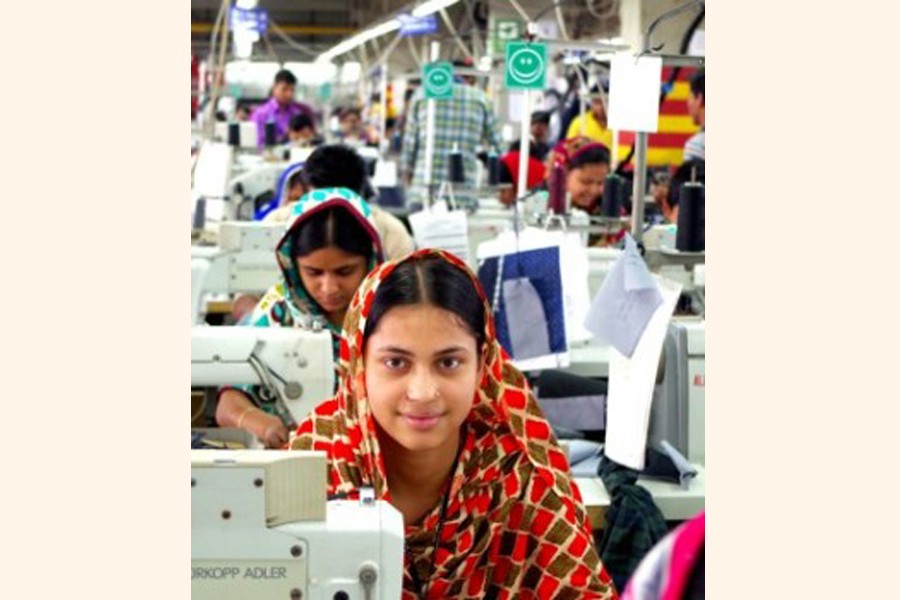
Published :
Updated :

Bangladesh's economy has successfully performed among the top 10 fastest-growing ones around the world. It grew at 7.28 per cent in the last fiscal year. As a consequence, it was its seventh year in a row that its GDP (gross domestic product) growth had exceeded 6.0 per cent. This pace might seem to be a small footstep in view of other giant nations and slowing down of the emerging countries. But, if we follow the statistics of our per capita income compared to our neighbouring country, India, then we will see our notable progress.
The per capita income of Bangladesh had grown by about 40 per cent while that in India grew at only 14 per cent. Bangladesh's annual GDP rose from $100 billion in 2009 to $250 billion in 2017, which shows a 150 per cent increase. At this speed, we may predict that Bangladesh could strike India's per capita income by 2020. Since 2006, Bangladesh has been leading from the front compared with the economy of Pakistan, which is also another giant economy of South Asia. It has exceeded Pakistan's development rate by more than 2.5 percentage points each year. Bangladesh even has a lower population growth rate than Pakistan. As a result, the per capita standard income of Bangladeshis is growing at a faster rate.
The economic freedom score of Bangladesh is 55.1, and placed 128th in the 2018 Index. Its overall score has increased by 0.1 point, with improvements in the scores for judicial effectiveness and government integrity in property rights, trade freedom, and labour freedom. Bangladesh has also diversified its economy. Much of its early growth came from the ready-made garment industry. Even the garment industry is diversifying its production. Along with basic shirts; Bangladesh also produces high-end sportswear that can be found in Europe's trendiest stores.
The World Economic Forum certified the present government's success in these metrics last year when it ranked Bangladesh first in gender equality among the South Asian nations for the second year in a row. The countries that can ensure matching the labour capacity are India, Bangladesh and Pakistan. These countries have millions of uneducated, unskilled and out of work labour forces. Yale economist Ahmed Mushfiq says Bangladesh's recent success can be attributed to two major factors: the flourishing garment manufacturing industry and the country's robust non-government organisation (NGO) sector. In 2015, Bangladesh fetched over $26 billion by exporting apparels, second only to China. Clothing exports make up almost 14 per cent of the GDP and 80 per cent of all exports. Estimates suggest the garment sector grew by over 10 per cent in 2016.
A key impediment to the economic progress of Bangladesh has been a general lack of mineral resources. Natural gas is used mainly in manufacturing fertilizer and for thermal power. More than half the proven gas reserves are in the Comilla area, and nearly all the rest is in Sylhet. The country's first oil well, near Sylhet, was established in 1986, but petroleum in marketable quantities has not been struck anywhere in Bangladesh. The country is strategically vital for the economies of Northeast India, Nepal and Bhutan, as Bangladeshi seaports provide maritime access for these landlocked sections and countries.
Bangladesh is very much vulnerable to natural disasters, especially flooding, and subdued foreign investment is weighing on prospective growth. The government should take measures to spur the country's economy, which relies on garment exports and remittances. Although economic development is expected to remain strong, challenges still remain.
Perhaps, global growth is fuelling the demand for Bangladeshi commodities. Moreover, the remittance inflow is also rising. The accommodation of Rohingya refugees in the east and the decision in June 2017 not to execute a new VAT law are also weighing on the fiscal sustainability. As domestic demand is leading to import expansion, it is also putting an added pressure on the current account.
The writer is a banker. At present, he is working for a private commercial bank.
Email: ahmed_shamir@live.com


 For all latest news, follow The Financial Express Google News channel.
For all latest news, follow The Financial Express Google News channel.